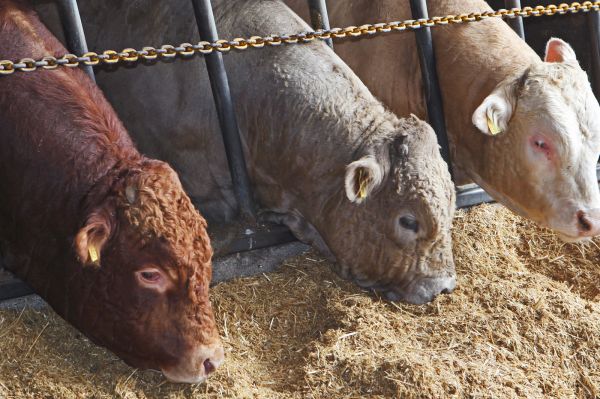A reliable alternative protein source

Maximise rumen performance
An energy-dense diet, maximising the use of homegrown and bought-in ingredients will help reach the desired market specs required by the processor. Farmers should also be aware of the importance of maximising the quality of homegrown ingredients. Producing high-quality grass silage with a high dry matter digestibility will have a huge impact on the overall diet cost.
he first quarter of 2023 was one of the best envisaged by beef farmers who were rewarded for their high levels of investment in purchasing animals and feed. Unfortunately, the positivity reversed as we moved into the second quarter, witnessing many upsets caused by reduced beef prices and high feed cost.
We are all aware of the finished specifications required by meat processors. To achieve the best beef price requires hitting these specs. To protect profitability, it is crucial that farmers know their finishing systems, and planning is strongly encouraged. Know your system, the capabilities of your farm, and what has worked well for you in the past. In addition, think about how purchased animals will fit into your finishing system.
"Alternative crops such as maize silage and fodder beet are also excellent sources of energy and can be very cost effective in finishing diets"
The importance of nutrition
Breeding or purchasing animals with high genetic merit sets the scene for high performance. However, it is the level of management – but more importantly, nutritional management – that will allow farmers to reach their maximum potential. Farmers are now consulting with on-farm nutritionists to formulate specific nutritional programmes to achieve the best results from their system.
A well-balanced and energy-dense diet is vital, which means farmers must maximise the quality of their feed ingredients, putting special emphasis on homegrown ingredients. Management that produces high-quality grass silage with high dry matter digestibility (>70 per cent) will save hugely on overall diet costs. Alternative crops such as maize silage and fodder beet are also excellent sources of energy and can be very cost effective in finishing diets.
Consistency
Consistency is another important component. By feeding the same diet each day, we ensure a consistently healthy rumen environment. The rumen is often referred to as the ‘engine’ in beef production, utilising ingested feed and converting it to beef. It is well known that feed costs represent 70 per cent of beef production costs, so we must provide a consistent diet to maintain a healthy and stable rumen, maximising feed utilisation. Inconsistencies in feeding may lead to reduced animal performance.
How can we unlock the benefits of maximised feed quality and consistency? There are various approaches, and many farmers today consult with on-farm nutritionists to formulate specific nutritional programmes that will achieve the best results. One constant, however, is that supplementation is key — and not all supplements are created equal.
A solution
Optigen, from Alltech, is a unique protein source that improves feed conversion in beef and dairy cattle through the provision of nitrogen for the rumen bacteria. Feeding Optigen optimises protein production in the rumen for improved animal health and performance and greater feed utilisation.
Optigen concentrates the nitrogen fraction of the diet, creating more dry matter space for energy and fibre sources. For instance, 100g of Optigen can replace up to 800g of soya bean meal. Optigen gradually degrades in the rumen, it meets the needs of the rumen bacteria more effectively and consistently than conventional protein sources. This results in increased microbial protein, enhanced fibre digestion of the animal’s diet, and increased energy available for meat production, meaning that more meat will be produced from the same amount of feed. It has a direct and beneficial effect on feed utilisation. It acts to provide a very stable protein source in the rumen, providing consistent levels of ammonia available over a sustained period of time. This ammonia can then be utilised efficiently by rumen bacteria.
When included in finishing beef diets, Optigen can improve daily liveweight gains by 92g per head per day. The average improvement in feed efficiency has been shown to work out at +12g of liveweight gain per kilogramme of dry matter intake per head.
Research
A recently published meta-analysis on the research and trial data of Optigen in beef production confirmed this technology’s ability to improve animal performance and profitability. The meta-analysis involved the extraction and comparison of the results obtained from 17 trials that involved the feeding of Optigen to finishing beef cattle. The original studies were conducted in nine countries: six in the US; two each in Uruguay, Brazil and Mexico; and one each in Italy, Egypt, Ireland, Portugal and Argentina. The research and trial work covered a 17-year period, from 2002-2018.
In addition to the specific liveweight gain and feed-efficiency benefits, the meta-analysis also confirmed the improved profitability that Optigen can offer, courtesy of the reduction in feed costs associated with beef production systems.
Optigen benefits the planet as well. The Carbon Trust has certified that the inclusion of Optigen in a ruminant animal’s diet can decrease the global warming potential of that diet. This leading environmental protection group has also validated that the replacement of high-carbon ingredients, such as soya, with Optigen significantly reduces the risk of having a high carbon footprint.
Optigen feeding rates range from 50-150g per head per day. The product can be added directly to a TMR on-farm or included in the formulation for a blend or pelleted feed supplied by a commercial feed manufacturer.




